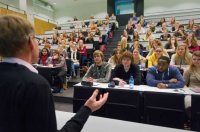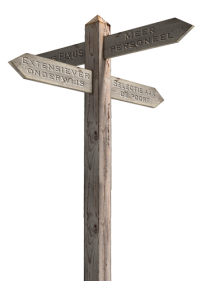Illustration: Paul Gerlach
Rik Leemans, professor of Environmental Systems Analysis, gives a concise explanation of the problem. Do the maths. ‘Our student numbers are growing by ten percent a year, so doubling every seven years. But an agreement in the past means our university’s education budget can’t increase by more than two percent a year. It therefore takes 34 years for that budget to double. So growth and the budget soon get out of sync.’
In everyday practice, that means more work pressure, among other things. An example from Leemans’ experience: ‘Ten years ago, the European Consultancy Workshop for Master’s students was organized once a year for 30 students. Now we are giving this course five or six times a year. The course lasts seven weeks, during which students spend two weeks abroad. In the past, three lecturers would have gone with them. But with six groups that would mean having 18 staff members away for two whole weeks. That’s not possible. So we have reduced the supervision to two teachers per group. Of course that will affect the quality.’
Student-staff ratios
Many chair groups are struggling with similar problems and need more teaching staff, as is shown by a survey that Resource carried out among full professors and education programme coordinators. Half of the professors say they have taken on additional staff to cope with the demand for teaching. More than 60 percent would like to hire even more staff but don’t have the money.
Other figures also point to this key factor underlying Wageningen’s growth problems. Arnold Bregt, professor of Geoinformation Science and Remote Sensing and the new Dean of Education, picks up a policy document on funding higher education that was recently sent to Parliament. Of all Dutch universities, Wageningen saw by far the biggest increase in student numbers, with a rise of more than 50 percent in the period 2011-2016. The student-to-staff ratio rose between 2006 and 2015 from seven students per teacher to 15. ‘The problem is that staff levels have remained roughly constant whereas student numbers have increased enormously,’ says Bregt. ‘While additional investments have been made internally in education, that has not always led to more staff being appointed.’

Sacco de Vries, a professor of Biochemistry, is scathing about the impact of the extra money that the Executive Board is making available for education according to the ‘Brascamp model’ in order to alleviate the situation. ‘I don’t see any difference in my staffing levels in the final analysis. The funding has increased but so have the other outgoings. The problem is that a lot of that extra money is then deducted to pay for accommodation, overheads, HRM, IT and other support departments. In practice, Biochemistry is smaller than it was 20 years ago. And that is definitely not the case for the support departments.’
Double the pressure
Leemans points to another facet of the money problem — the tenure track. He does not see anything wrong with the career instrument itself. ‘It lets young lecturers progress to becoming a professor holding a personal chair within ten years. That demonstrates an ambition to go for high quality in both research and teaching. But that does mean that successful chair groups like ours are gradually becoming more expensive because a higher position implies a higher salary. That is why we are barely able to take on any more staff. Using assistant professors and personal professors for teaching is not really financially viable.’
Leemans points to another facet of the money problem — the tenure track. He does not see anything wrong with the career instrument itself. ‘It lets young lecturers progress to becoming a professor holding a personal chair within ten years. That demonstrates an ambition of having high quality in both research and teaching. But that does mean that successful chair groups like ours are gradually becoming more expensive because a higher position implies a higher salary. That is why we are barely able to take on any more staff. Using assistant professors and personal professors for teaching is not really financially viable.’
Lower education standards
The pressure on the education side is affecting research in other ways too. According to Leemans in Environmental Systems Analysis, the pressure of work is giving researchers less and less time for writing good proposals to secure funding. ‘So you drop the step of having your proposal reviewed by a colleague. That means the proposals are poorer quality and there is less money coming in.’
Students’ practical skills have declined across the board
De Vries at Biochemistry also points to the gradually declining standard of the education, which also impacts on the research. ‘You see it in particular in the Master’s thesis, where students do research in the chair group. The students vary a great deal in their capabilities at the start. They are good on the theory but less so on the practice.’ The PhD candidates supervising them spend a lot of time teaching the students basic skills, time that could have been spent on their own research. ‘In the past we had ten MSc students in the room but now it’s just five or six because the supervision takes up so much time. And it’s not just the international students. Students’ practical skills have declined across the board. I’m already getting comments from companies that our students have difficulties with the practical work.’
Tipping point
Increasing workloads, stagnating budgets and increasing pressure on the quality of teaching and research inevitably raise the question of whether Wageningen can still cope with the growth if it continues like this, say the professors. ‘When I started as a professor here 20 years ago, Wageningen was at death’s door,’ recalls the new head of education Bregt. ‘Student numbers were really low. A new education policy was introduced then that we still cherish. Good quality teaching on a small scale in attractive buildings with decent facilities. That worked. But is that approach still appropriate? The current education model is reaching the limits of what is possible. The small scale with a lot of contact between teaching staff and students is highly valued by the students. But there is a tipping point and some chair groups and degree programmes have already reached that point.’
The current education model is reaching the limits of what is possible
Bregt says the biggest problem is in the supervision of thesis students. ‘That thesis is an essential part of their degree. That is when students learn to do research. It’s the stage at which a lot of skills are learned. We need to do something about that bottleneck, and I have an idea what. Perhaps we shouldn’t be looking at the education side for a solution but instead consider strengthening the research. Student numbers have doubled but the research budget has remained virtually unchanged in all that time. What if each chair group were to use ten percent of the education budget for additional research? That would come to 60,000 to 100,000 euros for an average chair group. That would enable you to hire a researcher. Taking the university as a whole, this would give 80 extra researchers. Unfettered research with no strings attached that produces thesis topics that students could work on.’

There is a price tag to transferring those funds. ‘You force chair groups to introduce more differentiation in the subjects. Broad where possible and focused where necessary, as in the thesis supervision. We can no longer afford to teach so intensively across the board like we used to. We are obsessively trying to preserve the old approach but with far larger groups of students. We can’t keep that up.’
Debate about growth
Quite apart from the adjustments in the short term, Bregt wants to start a structural debate about growth. ‘What kind of a university do we want to be in terms of size and setup? An MIT-style institution in which the purpose of the students is to support the research, or an education hub? I want to develop three scenarios, including calculations of the financial effects and of what it means for staffing levels. At the moment, growth is something that just happens’.
Hydrologist Uijlenhoet also agrees that a debate about growth is needed. ‘It is time to reconsider. Let’s pause for a moment. If it is already clear that staff numbers aren’t going to keep pace with the growth, you have to think hard about whether you want to continue growing. Everyone is working their fingers to the bone to keep everything going. The education model and recruitment of students have been incredibly successful. Mission accomplished. But now it is time to see how we want to develop over the next 10 to 20 years.’
Setting limits
‘Great, a debate like that on growth,’ says Leemans, ‘because I don’t have the solutions. I have repeatedly raised the work pressure problem with the directors over the past four years but they just refer it back to the chair groups. The Executive Board came up with the solution of bringing in DLO workers for teaching tasks but that is just not possible. They are much too expensive. My solution is to use PhD candidates for teaching but that is at the expense of their research. If more money for lecturers is not an option, we’ll have to set limits on the growth or even return to taking on fewer students.’
We should adjust student numbers to match the available staff
Assistant professor Frits Claassen in Operations Research and Logistics disagrees. ‘Growth is a nice problem to have and a challenge. I remember the days of falling numbers, when our university was under a dark cloud. And look at what we have now! Fantastic.’ But this does not mean he is blind to the issues. Claassen thinks a great deal would be achieved just by giving teaching the position and appreciation it deserves. ‘At present, the incentives are weighted too much towards research and securing new projects. Research brings in rewards but that is hardly the case for education at all. Give young tenure track staff who are good at teaching career prospects and the opportunity to develop themselves. I’m convinced there is a lot of educational talent among the young staff. But you have to pick them out and that isn’t happening. There are PhD candidates who are barely involved in course teaching at all. Isn’t that a bit odd? PhD candidates and postdocs are the new generation of researchers and lecturers.’
Admission criteria
According to Uijlenhoet, any debate about growth needs to include the question of the quality of the students who are admitted. ‘You need to be careful not to fall into the trap of thinking everything used to be better in the past, so I want to make that proviso. But it does seem as if there is greater variation in the standard and ambitions of the students we take on, both in the Bachelor’s and in the Master’s. There are still first-class students but there is a long tail of students who require a disproportionate amount of attention. In Wageningen all you need for admission is a VWO [secondary school] certificate. You might ask whether that low hurdle is future-proof. Nowadays, we are increasingly recruiting students who might be better off at a university of applied sciences.’

Uijlenhoet thinks Wageningen should present itself more as a technical university. ‘We have joined the 4TU Federation and that’s a good move. We are a university that is geared to technical applications so we should convey that message. We train engineers. Send the message that you have to work hard here and not everyone with a VWO certificate will make it.’
‘For years it was not the done thing to study in Wageningen,’ says De Vries (Biochemistry). ‘Now we make the front page of the Volkskrant newspaper every week. That’s great. But then you also get students who don’t have a correct picture of what a Wageningen degree involves. Perhaps we should reverse things, take the available staff as our starting point and adjust the student numbers to match.’
Growth dossier
The continuing growth in the number of students is a hot topic in Wageningen. Last month, Resource conducted a survey to get a good picture of the impact on staff. That shows that the pressure of work is high and teaching has become less individual. The results were published in Resource 19. In Resource 20, teaching staff talked about how they have changed their working methods to cope with the growth. In this final follow-up article, professors are advocating a university-wide debate about the growth.

